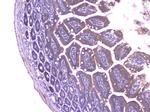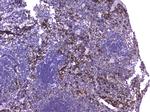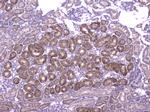Search Thermo Fisher Scientific
FIGURE: 1 / 4
MCP-2 Antibody (PA5-95539) in IHC (P)




Product Details
PA5-95539
Species Reactivity
Host/Isotype
Class
Type
Immunogen
Conjugate
Form
Concentration
Purification
Storage buffer
Contains
Storage conditions
Shipping conditions
RRID
Product Specific Information
Reconstitute with 0.2 mL of distilled water to yield a concentration of 500 µg/mL.
Target Information
This antimicrobial gene is one of several chemokine genes clustered on the q-arm of chromosome 17. Chemokines form a superfamily of secreted proteins involved in immunoregulatory and inflammatory processes. The superfamily is divided into four subfamilies based on the arrangement of N-terminal cysteine residues of the mature peptide. This chemokine is a member of the CC subfamily which is characterized by two adjacent cysteine residues. This cytokine displays chemotactic activity for monocytes, lymphocytes, basophils and eosinophils. By recruiting leukocytes to sites of inflammation this cytokine may contribute to tumor-associated leukocyte infiltration and to the antiviral state against HIV infection.
For Research Use Only. Not for use in diagnostic procedures. Not for resale without express authorization.
References (0)
Bioinformatics
Protein Aliases: C-C motif chemokine 8; MCP-2; Monocyte chemoattractant protein 2; monocyte chemoattractant protein-2; Monocyte chemotactic protein 2; small inducible cytokine A8; Small-inducible cytokine A8
Gene Aliases: 1810063B20Rik; AB023418; Ccl8; HC14; MCP-2; Mcp2; Scya8
UniProt ID: (Mouse) Q9Z121
Entrez Gene ID: (Mouse) 20307

Performance Guarantee
If an Invitrogen™ antibody doesn't perform as described on our website or datasheet,we'll replace the product at no cost to you, or provide you with a credit for a future purchase.*
Learn more
We're here to help
Get expert recommendations for common problems or connect directly with an on staff expert for technical assistance related to applications, equipment and general product use.
Contact tech support
